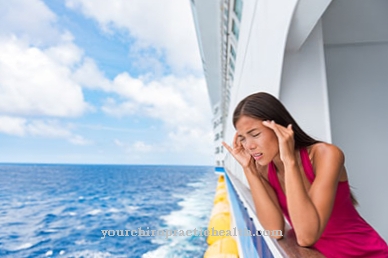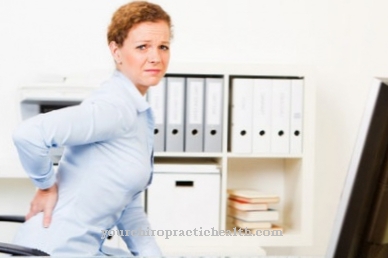Many people have already experienced situations in life in which they felt uncomfortable and dizzy as a reaction to unusual movement. This so-called movement vertigo or the travel sickness is also known as Kinetosis.
What is motion sickness?

© Maridav - stock.adobe.com
The travel sickness is widespread and can be found in different forms, often in the course of arrival and departure with unfamiliar vehicles. The following is an overview of the definition, symptoms, diagnosis, causes, treatment and prevention of kinetosis.
Kinetosis or motion sickness is generally used to describe physical complaints that can occur with unusual movement on or in a vehicle, with vibrations in upper floors of high buildings or simulated movements through interactive images.
The best-known form of kinetosis is seasickness, which can be triggered by the undulating movement of a ship in rough seas. It can also happen that people who have not had problems with seasickness for years also experience kinetosis later, while others remain immune to motion sickness for their entire life.
In more severe cases, however, kinetosis can also lead to cardiovascular complaints, which must be treated with caution, as in rare cases they can also lead to death.
causes
A travel sickness can occur when a conflict in the brain arises from the fact that sensed impressions can no longer be related. The eyes and sense of balance send different perceptions and cause nausea.
For example, while on a passenger ship movement is perceived but not visualized, in a car speed is only seen, but not actively perceived. This form of passive movement, which can also be felt in skyscrapers or in elevators, can cause kinetosis.
Fearful and insecure people complain more often of motion sickness, fear of flying and negative expectations also have an impact on susceptibility to motion sickness. Those who are frequently affected by migraines are also considered to be more susceptible to kinetosis.
Symptoms, ailments & signs
Motion sickness can have different degrees of severity. Symptoms can appear before and during travel. The signs are particularly noticeable due to a sea voyage. In the preliminary stages of a trip, those affected experience the onset of nervousness, occasional discomfort and slight pressure in the epigastric region.
It can also lead to cold sweats and shivering. Unfamiliar movement with a means of transport can result in motion sickness (kinetosis) as a pale complexion and dizziness. These can develop into serious circulatory disorders.
Typical signs of kinetosis are headaches, nausea and vomiting, which are particularly common on a restless sea voyage. The stomach and intestinal functions are restricted. Heartburn can occur. Breathing speed can increase and sweating can occur more frequently.
In this condition an accelerated heartbeat can be determined. At the same time the blood pressure drops. In individual cases, sick people feel particularly weak and almost apathetic. There is general tiredness and listlessness. Symptoms of motion sickness are also excessive yawning, a queasy feeling in the stomach and increased, almost compulsive swallowing.
Those affected speak less, react more slowly and appear disinterested. There is a lack of drive. Another sign of motion sickness is loss of appetite. In severe cases, palpitations are also considered a symptom of motion sickness. In addition to a pale complexion, there may also be significant reddening of the face in individual cases.
Diagnosis & course
A travel sickness can always be diagnosed if the symptoms described above occur suddenly and without physical cause as a reaction to unusual movement. Those who rarely take the train, fly or travel by ferry may be affected by motion sickness every time.
Normally, the kinetosis subsides after a few days when traveling long-distance on a ship or with getting used to an unfamiliar living situation, regular flights or long car journeys. Motion sickness manifests itself in symptoms such as nausea, dizziness, vomiting or malaise, headache or paleness.
Complications
Motion sickness can cause a number of complications. First of all, the disease leads to gastrointestinal complaints - dehydration and deficiency symptoms can occur. In the elderly, children and sick people, excessive fluid loss can be life-threatening. Motion sickness can also lead to hyperventilation and shortness of breath.
At the same time, blood pressure usually falls and the heartbeat accelerates. In rare cases the disease leads to circulatory collapse. In general, there is a sharp decrease in well-being - a symptom that can lead to problems in people with previous mental illnesses. Adverse events can also occur during treatment.
The typically prescribed drug scopolamine often causes temporary dry mouth, rapid heartbeat, and blurred vision. Occasionally, after ingestion, drowsiness, lower blood pressure and irritation of the eyelids occur. Memory and concentration disorders, hallucinations and balance disorders can rarely occur, occasionally also temporary psychoses and acute glaucoma attacks.
Similar side effects and interactions are conceivable after taking meclozin, dimenhydrinate and other drugs. If the affected person has to be given intravenous fluids, infections, edema and other symptoms can occasionally occur.
When should you go to the doctor?
The motion sickness does not normally require medical treatment. The complaints occur in connection with movement or an internal stress experience while traveling. In most cases the discrepancies are temporary and spontaneous healing occurs. If symptoms occur regularly and are directly related to a trip, a doctor or therapist should be consulted in advance. There are various options that can be used before starting a trip. In addition, self-help measures can be used to bring about an improvement in health.
If there are severe health problems, a doctor is required. Dizziness, vomiting, pale appearance, and diarrhea should be observed. If the symptoms increase or persist over a longer period of time, they should be presented to a doctor. Listlessness, tiredness and changes in behavior are also signs of motion sickness. In severe cases, a doctor is needed.
Disturbances in consciousness, sweats and irregularities in memory are considered worrying. A doctor is needed if there is no improvement or if there are additional cardiovascular disorders. If the trip has to be canceled or interrupted due to the complaints, this is an indication that should be followed up. Sleep disorders, disorientation, and apathy should be discussed with a doctor.
Treatment & Therapy
For acute complaints by a travel sickness the patient is primarily advised to bring the imbalanced impressions of the balance organs and eyesight back into harmony and to visualize the movement.
In the car, looking out onto the road or a fixed point on the horizon helps. Those who are prone to kinetosis when driving by car, train or bus should also sit as far in front as possible, where the vehicle sways the least and movement is the least. The risk of getting motion sick is also higher in seats facing away from the direction of travel.
Closed ship cabins should also be avoided in case of kinetosis. It is best to look through a window or onto the deck of the surrounding undulations that are causing the nausea.
In some cases, conscious relaxation and meditation can counteract kinetosis. If no improvement can be achieved, the patient should be placed on their back; optimally to alleviate the disease is sleep, during which the sense of balance is not stimulated.
Medicinal forms of treatment are controversial and should only be used if the symptoms could not be alleviated otherwise. If necessary, a doctor should be entrusted with treating the kinetosis.
prevention
One travel sickness In some cases, prevention in children can be achieved by postponing the trip to the night and sleep thus preventing possible symptoms. If you are affected yourself, you should avoid stimulants such as coffee or alcohol, as well as food that is heavy in the stomach the day before. For many people, chewing gum or even ingesting rusks or savory biscuits on an irritated stomach helps against kinetosis.
Aftercare
Since the symptoms usually subside on their own shortly after the triggering stimuli have ceased, comprehensive follow-up care is not required. Until the symptoms have completely subsided, however, those affected should take it easy and not strain themselves physically. An adequate supply of fluids and nutrients generally contributes to a quick recovery and can thus support the body's natural ability to regenerate.
In addition to water, we recommend light meals with a high water content that do not put additional strain on the stomach. However, fatty foods, coffee and alcohol are not advisable. If the motion sickness has been treated with medication or otherwise, any after-effects of the substances ingested must also be taken into account. Some common preparations affect the ability to concentrate and cause tiredness.
If patients notice these side effects or if the information leaflet provides information, they should not drive independently until the impairment has completely subsided. If the motion sickness persisted for several hours or days as a result of prolonged exposure, particular care is required when assessing the general condition.
In particular, large fluid losses through vomiting must be gradually compensated for in order to prevent circulatory problems. More extensive follow-up measures may also be necessary for patients with cardiovascular diseases, whose health values could be impaired by the disease. In this case, it is recommended to check the blood pressure or insulin values.
You can do that yourself
Motion sickness is an annoying evil that is not uncommon. However, self-help is quite possible with this disease, especially if the disposition to do so is already known in advance. Prevention and help in acute cases are accessible to self-help.
Anyone who knows that they suffer from motion sickness can prepare specifically for journeys by car, ship and flights. Homeopathic active ingredients are often helpful in this context and are available over the counter in drug stores or pharmacies. Attention should also be paid to diet. Food shouldn't be heavy in the stomach, but a completely empty state should also be avoided. Anyone looking outside should always do so through a front window. Sliding objects past side windows can increase motion sickness.
If motion sickness has broken out, a break in the fresh air is often helpful. It is best combined with light movement. If this is not possible on an airplane, for example, nausea can be relieved by herbal remedies. In the event of vomiting, lost fluids should be replaced quickly if drinking is possible. Closing your eyes can reduce the symptoms that often arise from looking outside. Often times, the flight attendant also has the opportunity to offer people affected by motion sickness a quiet seat.

.jpg)
.jpg)

.jpg)

.jpg)







.jpg)













